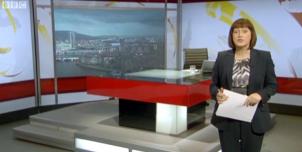Full Freeview on the Divis (Northern Ireland) transmitter
| Google Streetview | Google map | Bing map | Google Earth | 54.607,-6.009 or 54°36'24"N 6°0'34"W | BT17 0NG |
The symbol shows the location of the Divis (Northern Ireland) transmitter which serves 440,000 homes. The bright green areas shown where the signal from this transmitter is strong, dark green areas are poorer signals. Those parts shown in yellow may have interference on the same frequency from other masts.
_______
Digital television services are broadcast on a multiplexes (or Mux) where many stations occupy a single broadcast frequency, as shown below.
64QAM 8K 3/4 27.1Mb/s DVB-T MPEG2
DTG-12 QSPK 8K 3/4 8.0Mb/s DVB-T MPEG2
H/V: aerial position (horizontal or vertical)
Which Freeview channels does the Divis transmitter broadcast?
If you have any kind of Freeview fault, follow this Freeview reset procedure first.Digital television services are broadcast on a multiplexes (or Mux) where many stations occupy a single broadcast frequency, as shown below.
64QAM 8K 3/4 27.1Mb/s DVB-T MPEG2
DTG-12 QSPK 8K 3/4 8.0Mb/s DVB-T MPEG2
H/V: aerial position (horizontal or vertical)
Which BBC and ITV regional news can I watch from the Divis transmitter?

BBC Newsline 0.6m homes 2.5%
from Belfast BT2 8HQ, 1,044km northeast (51°)
to BBC Northern Ireland region - 46 masts.
Are there any self-help relays?
| Chapel Fields | Transposer | Central Belfast | 61 homes |
How will the Divis (Northern Ireland) transmission frequencies change over time?
| 1950s-80s | 1984-97 | 1997-98 | 1998-2012 | 2012-13 | 4 Mar 2020 | ||||
| VHF | A K T | A K T | A K T | K T | W T | ||||
| C1 | BBCtvwaves | ||||||||
| C21 | C4waves | C4waves | C4waves | +D3+4 | D3+4 | ||||
| C23 | SDN | SDN | |||||||
| C24 | ITVwaves | ITVwaves | ITVwaves | BBCB | BBCB | ||||
| C26 | ArqA | ArqA | |||||||
| C27 | BBC2waves | BBC2waves | BBC2waves | BBCA | BBCA | ||||
| C29 | ArqB | ||||||||
| C30 | LBT | ||||||||
| C31 | BBC1waves | BBC1waves | BBC1waves | ||||||
| C33 | com7 | ||||||||
| C34 | com8 | ||||||||
| C36 | _local | ||||||||
| C48 | NIMM | NIMM | |||||||
| C55tv_off | com7tv_off | ||||||||
| C56tv_off | COM8tv_off |
tv_off Being removed from Freeview (for 5G use) after November 2020 / June 2022 - more
Table shows multiplexes names see this article;
green background for transmission frequencies
Notes: + and - denote 166kHz offset; aerial group are shown as A B C/D E K W T
waves denotes analogue; digital switchover was 10 Oct 12 and 24 Oct 12.
How do the old analogue and currrent digital signal levels compare?
| Analogue 1-4 | 500kW | |
| BBCA, D3+4, BBCB | (-7dB) 100kW | |
| SDN, ARQA, ARQB | (-10dB) 50kW | |
| com8 | (-16dB) 12.7kW | |
| com7 | (-16.1dB) 12.4kW | |
| LBT | (-20dB) 5kW | |
| Mux 1*, Mux 2*, Mux A*, Mux B* | (-23.4dB) 2.3kW | |
| Mux C* | (-24dB) 2kW | |
| Mux D* | (-24.9dB) 1.6kW | |
| NIMM | (-47dB) 10W |
Which companies have run the Channel 3 services in the Divis transmitter area
|
|
Monday, 31 December 2012
G
gerard duffy1:44 PM
Thanks, Dave - my VHF signal indeed was from Truskmore.
Cheers for going to so much trouble!
Do you think if I purchased another UHF aerial and pointed that at Truskmore I might get RTE? My VHF aerial now is no use? I'd also need a another UHF aerial and a Saorview box?
| link to this comment |
gerard duffy: You are right, the VHF aerial is now of no use for picking up TV.
A Freeview HD receiver will definately receive Saorview; Freeview standard definition may or may not.
Saorview uses the DVB-T signal standard and pictures are encoded using MPEG4. Freeview standard definition also uses DVB-T, but pictures are encoded using the earlier MPEG2 standard. For this reason, quite a few Freeview standard definition receivers won't be able to show the Saorview pictures.
If you can receive from a Saorview transmitter, then you can connect the feeds from two aerials together using a diplexer providing that the channels used by each transmitter allow:
Online TV Splitters, Amps & Diplexers sales
For example, uses 39, 42 and 45 and Truskmore uses 53 (and prospectively 57 in the future), so a diplexer that "splits" at C51 will work. This will allow you to view Saorview and Freeview on the same receivers; or alternatively you could keep them separate and use a separate Saorview box.
This is perhaps getting a little ahead, but really the only way is to have an installer visit you to pass judgement whether you might be able to pick-up from Truskmore or any other Saorview transmitter.
Coverage maps are only a rough guide and don't necessarily relate to the real-world situation of what can and can't be picked up.
Letterkenny @ 2kW is about 15 miles away, but again we assume that the chances of reception diminish the lower down you are. Plus Truskmore and Letterkenny are co-channel, albeit that the latter is vertically polarised. This probably explains the reason for the slight notch in Truskmore's radiation pattern in the direction of Letterkenny. There is nothing to be lost by manually scanning C53.
Failing that, call an aerial installer.
And have a look around to see what others around you have done.
| link to this comment |
Wednesday, 16 January 2013
L
Lynn Steenson10:32 PM
We live in Clontibret Co. Monaghan.
Before the DSO we received all freeview channels from Divis. We have a high gain digital horizontal aerial.
Since the DSO we can only get PSB1,PSB2 + PSB3 multiplexes. We cant get COM4 COM5 or COM6 multiplexes.
Any ideas what we could do to get all the freeview channels that we did before the DSO.
(aeriel has not been touched).
| link to this comment |
Thursday, 17 January 2013
P
Peter Henderson1:09 AM
Newtownabbey
It may possibly be too nmuch gain Lynn. If you have an amplifier try removing it, or you may need to fit an attenuator.
Another thing to bear in mind is that some Freeview STBs/TVs have built in amplifiers. If this is the case then switch it off in the menu system. Look for something such as "antenna power" or similar.
| link to this comment |
Peter's: mapP's Freeview map terrainP's terrain plot wavesP's frequency data P's Freeview Detailed Coverage
Lynn Steenson: Go to the manual tune function on your receiver and see if it might give you some indication as to the strength and quality of the three COM muxes as they may be sitting just below the strength your receiver needs to show them or they may be above but of too poor a quality.
Once you have the manual tune screen up, select the UHF channel and give it five or 10 seconds. See if it gives an indication of strength and/or quality *before* you press the button to scan the channel. Do this for each of the COMs.
| link to this comment |
Lynn Steenson: There is no such thing as a "digital aerial" as set against an "analogue aerial". Aerials work based on frequencies received and those used for TV after switchover are the same as those used before.
If your aerial is a yagi-type, which it is likely to be if it is a "high-gain" one, then it won't be "high" gain on the low (Group A) channels used by Divis if it is a wideband. That said, if it worked prior to switchover, then maybe you aren't too far off; perhaps additional or even less amplication, as suggested by Peter, is the answer.
| link to this comment |
L
Lynn Steenson1:46 PM
Peter Henderson: I cant find a built in amplifier option on the tv.
Could gain be a problem after DSO?
Exact same aerial/amplifier setup before DSO and we were receiving all freeview channels before?
Could it be because Divis is only broadcasting the COMs at half the strength of the PSBs? 100,000 watts for PTSBs and COMs only at 50,000 watts?
Is this likely to change?
| link to this comment |
L
Lynn Steenson1:57 PM
Dave Lindsay:
The aerial isnt a yagi .
From reading the aerial page here I think it falls into the Digital High Gain class 2 category.
It is described as "48 Element High Gain Digital TV Aerial".
All freeview channels were being received before the DSO using this exact same aerial set up.
I cant get any indication of strength/quality for any of the COMs.
Would it be down to the different output power levels from Divis?
| link to this comment |
L
Lynn Steenson3:08 PM
Dave Lindsay: I have discovered the antenna levels for the Coms *before* scan are:
COM 4: antenna level 58 quality 0
COM 5: antenna level 50 quality 0
COM 6: antenna level 38 quality 0
The Coms we cant get are listed in the guide but once you select them there is no picture.
On doing this I was able to get another reading of the strength/quality of the channel.
E.g.
Dave in COM 5: signal strength 92 quality 0
Quest in COM 4: signal strength 95 quality 0
and to compare
UTV in PSB2: signal strength 99 quality 100
BBC1HD in PSB3: signal strength 96 quality 100
Does this shed any light on what is goin on?
| link to this comment |
Lynn Steenson: The COM strengths would be expected to be the same whether you go through the manual tune screen and enter the UHF channel or (with the services, e.g. Dave, stored) bring up the signal strength screen, so I'm not sure why you got lower readings then. The only thing to say is that you might have to give it a few seconds (10 maybe) to settle.
That said, the strengths being in the mid to high 90s could perhaps be an indication that they are too great, presumably being driven that high due to your amplifier. I suggest that you try reducing the level of amplification so you get around 75% to 80%. It isn't critical; quality is the important thing with digital reception.
If the signals are on the high side, say verging on excessive (for what your tuner can cope with), then that is akin to turning the volume right up to maximum on your hifi. What happens is the sound distorts and quality is lost. The COMs use a signal type that isn't as rugged as the PSBs, which could explain why they are lost and the PSBs aren't - this is my suggested explanation if you find that reducing the level of amplification does the trick.
You may even find that the amp isn't needed at all. You are around 30 miles from the transmitter and I believe that you even reside in the area coloured green in the map above.
You should also be able to combine the feed from the Divis aerial and that of, Monaghan I guess, so you can view both Saorview services and Freeview services on the same/all receivers. For this you will need a diplexer - probably one that splits at C51.
| link to this comment |
Select more comments
Your comment please







